This post contains affiliate links, which means I may earn a commission if you purchase through those links (at no extra cost to you).
If you love pickles and you love garlic, this pickled garlic recipe is super simple to make and keeps in the refrigerator for a few months! Not suitable for canning.
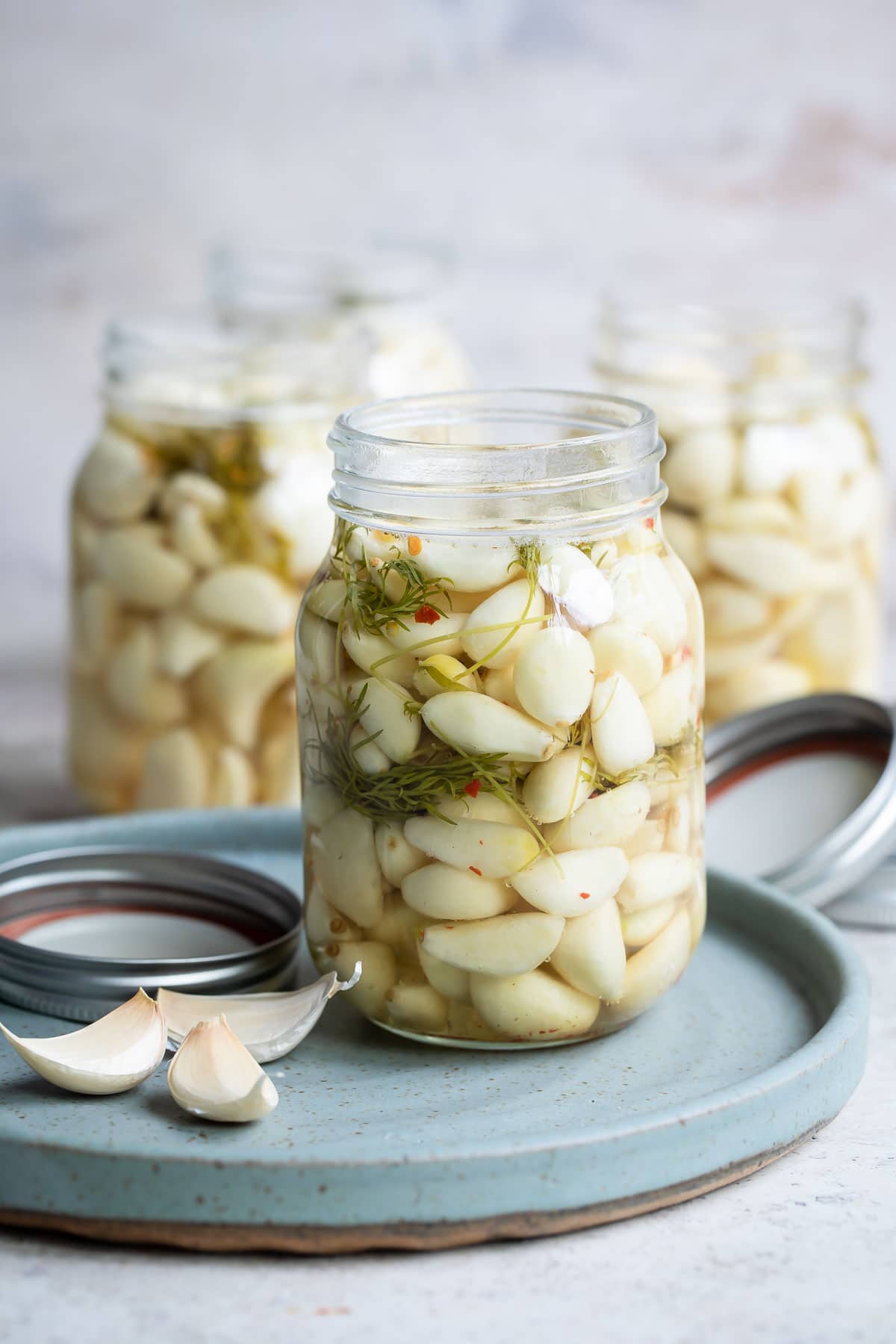
Several years ago, I was discussing Dilly Beans with my mother-in-law. She made them for a church fundraiser, and she was planning to set aside a jar for me as a Christmas gift. Would I like a clove of garlic in my jar of Dilly Beans?
My response? “Could I please have a whole jar of Dilly Garlic?” I’m so grateful she agreed!
Recipe ingredients
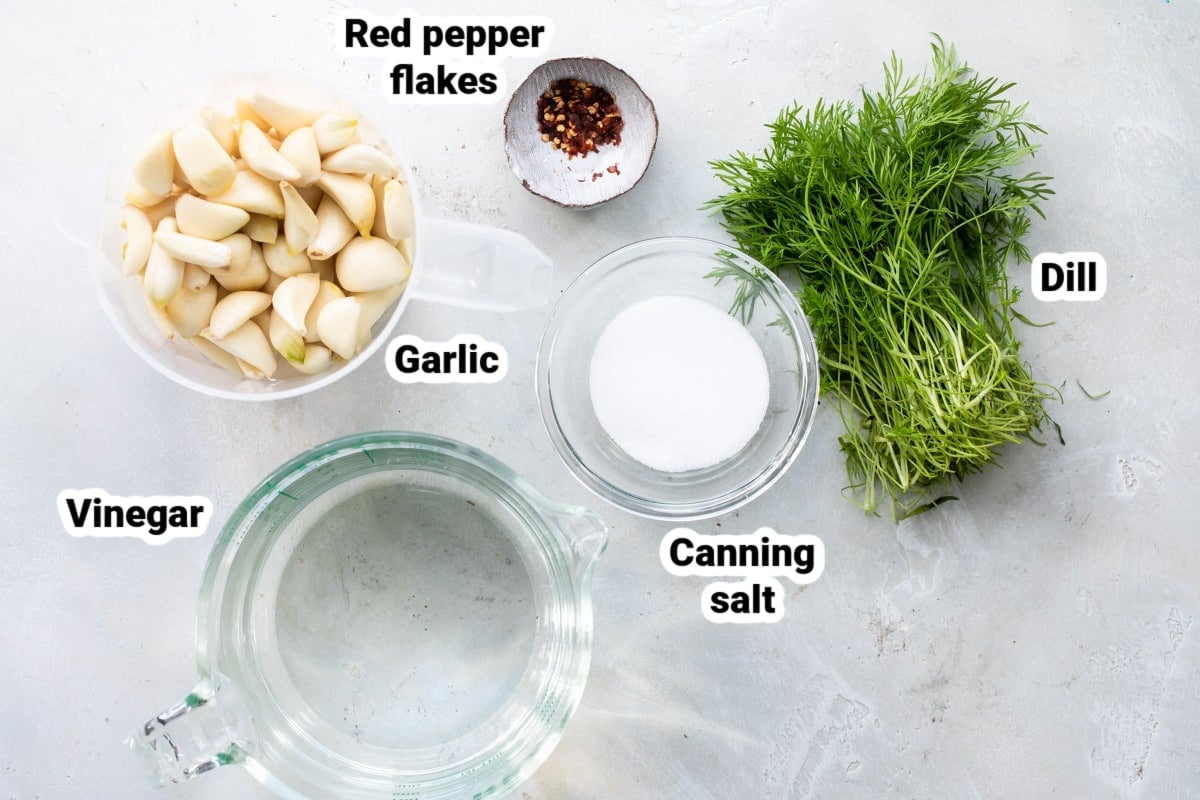
At a Glance: Here is a quick snapshot of what ingredients are in this recipe.
Please see the recipe card below for specific quantities.
Ingredient notes
- WARNING: This recipe is not suitable for shelf-stable canning. Obviously people (or companies) sell shelf-stable pickled garlic, but I am not an expert in this area and garlic has a propensity to develop botulism. So, if you make this recipe, you MUST store it in the refrigerator. Even if you seal the jars with a water bath. Refrigerate! “Canning of garlic is not recommended. Garlic is a low-acid vegetable that requires a pressure canner to be properly processed. Garlic loses most of its flavor when heated in this way. For this reason, adequate processing times have not been determined for canning garlic.”
Step-by-step instructions
- Combine canning salt and vinegar in a large saucepan. Bring to boil; reduce heat and simmer 10 minutes (180 degrees). Meanwhile, pack garlic into 4 sterilized pint jars (about 8 ounces per jar) leaving 1/2-inch of headspace. Add ¼ teaspoon red pepper flakes and 1 head of dill to each jar. (If using fresh dill, add ½ cup to each jar.)

- Using a ladle, divide hot pickling liquid between the 4 jars, leaving 1/2-inch of headspace. Remove air bubbles, clean jar rims, center lids on jars, and adjust band to fingertip-tight.
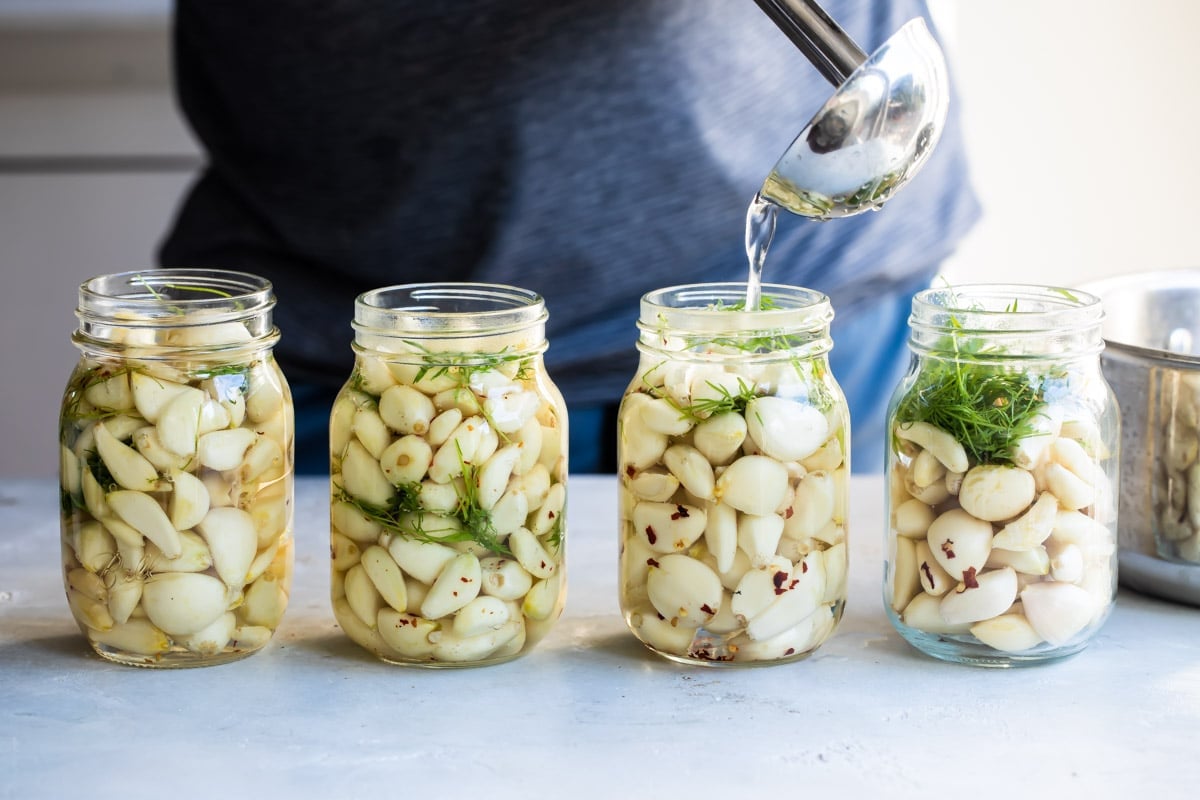
- Chill in the refrigerator until pickled as desired (I recommend at least 3 weeks in the refrigerator). Store in refrigerator for up to 4 months (see notes) or seal jars following the instructions below (the pickled garlic must still be refrigerated; it will not be shelf-stable).
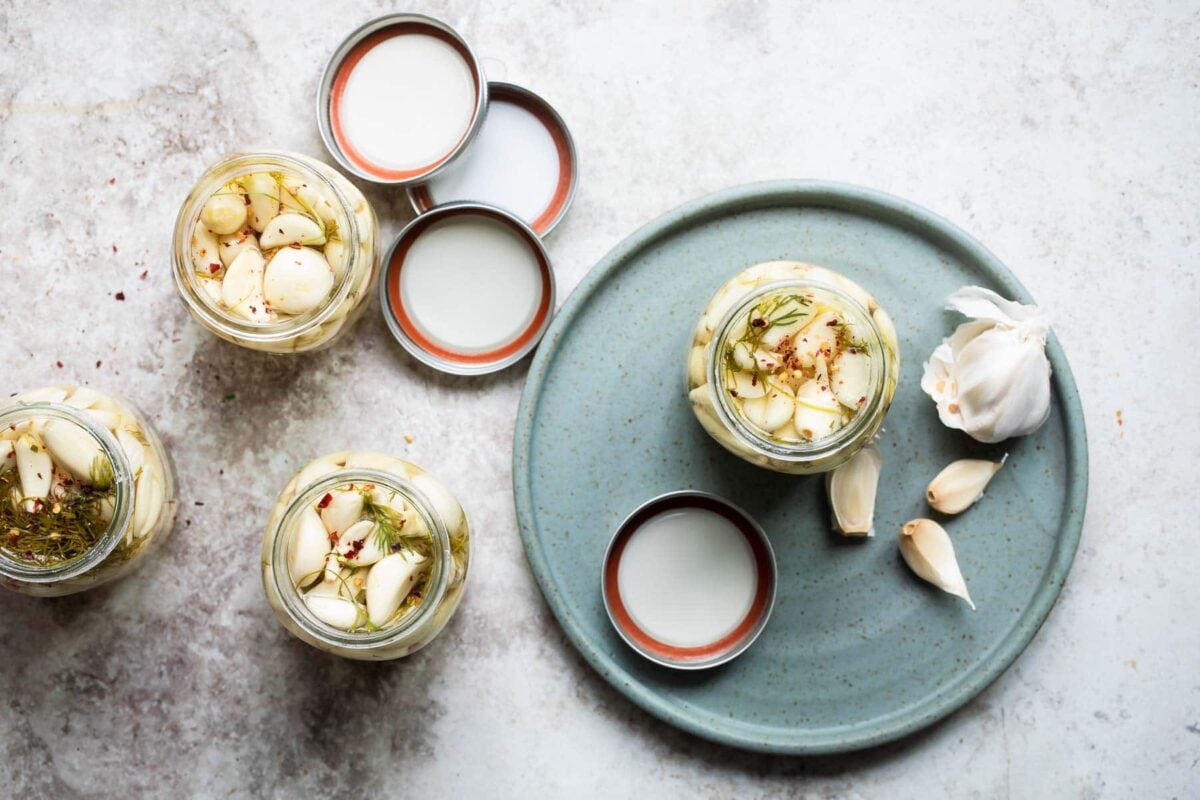
Recipe tips and variations
- Yield: This recipe makes 4 pints (8 cups), enough for 32 servings, ¼ cup each.
- Storage: The National Center for Home Food Preservation states that the garlic and vinegar mixture may be refrigerated for up to 4 months. It’s safe to use the flavored liquid for other things. Discard if you see any signs of mold or yeast growth.
- Blue garlic: Sometimes pickled garlic turns blue or turquoise when you pickle it. It’s completely normal and still safe to eat and you don’t need to worry. You can read all about the chemistry of garlic (and exactly why it may or may not turn blue). To prevent the bluish color:
- User kosher salt or sea salt to avoid iodine
- Use stainless steel or enamel cookware and utensils (avoid copper, aluminum, cast iron, and tin cookware and utensils)
- Reduce chlorophyll production by avoiding sunlight
- Use distilled water to avoid the trace minerals found in tap water
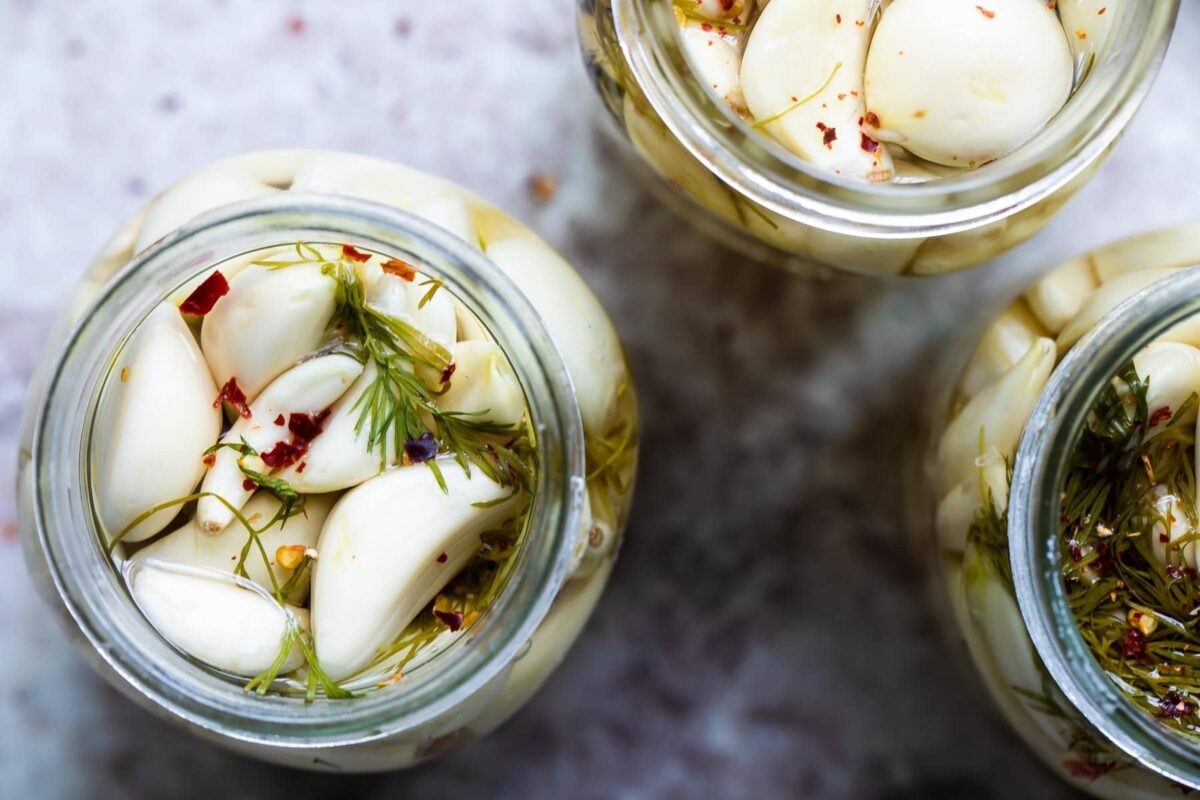
Bloody Mary Bar
Lazy weekends and holiday mornings call for a Bloody Mary Bar with homemade mix and all the savory pickled stuff you can find. It’s a total crowd-pleaser; from the purists to the meal-in-a-glass folks, everyone…
View RecipePut your pickled garlic to work
Entertaining
Midwest Charcuterie Board
Italian Recipes
Antipasto Platter
Appetizer Recipes
Jarcuterie
Appetizer Recipes
Ham Roll Ups
Join Us
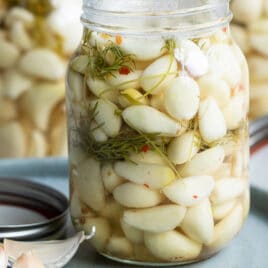
Pickled Garlic
Equipment
Ingredients
- 1/4 cup canning salt
- 5 cups white vinegar
- 2 pounds fresh garlic peeled
- 1 teaspoon red chili flakes
- 4 heads fresh dill or 2 cups fresh, stems and leaves coarsely chopped
Instructions
- Combine canning salt and vinegar in a large saucepan. Bring to boil; reduce heat and simmer 10 minutes (180 degrees).
- Meanwhile, pack garlic into 4 sterilized pint jars (about 8 ounces per jar) leaving 1/2-inch of headspace. Add ¼ teaspoon red pepper flakes and 1 head of dill to each jar. (If using fresh dill, add ½ cup to each jar.)
- Using a ladle, divide hot pickling liquid between the 4 jars, leaving 1/2-inch of headspace. Remove air bubbles, clean jar rims, center lids on jars, and adjust band to fingertip-tight.
- Chill in the refrigerator until pickled as desired (I recommend at least 3 weeks in the refrigerator). Store in refrigerator for up to 4 months (see notes) or seal jars following the instructions below (the pickled garlic must still be refrigerated; it will not be shelf-stable).
To seal jars (MUST BE REFRIGERATED, NOT SHELF-STABLE):
- Process jars in boiling water for 10 minutes. The jars must be covered by at least 1 inch of water. Turn off heat and remove cover. Let jars cool 5 minutes. Cool 12 hours. Check seals. Chill in the refrigerator until pickled as desired (I recommend at least 3 weeks in the refrigerator). Store in refrigerator for up to 4 months (see notes).
Recipe Video
Notes
- WARNING: This recipe is not suitable for shelf-stable canning. Obviously people (or companies) sell shelf-stable pickled garlic, but I am not an expert in this area and garlic has a propensity to develop botulism. So, if you make this recipe, you MUST store it in the refrigerator. Even if you seal the jars with a water bath. Refrigerate! “Canning of garlic is not recommended. Garlic is a low-acid vegetable that requires a pressure canner to be properly processed. Garlic loses most of its flavor when heated in this way. For this reason, adequate processing times have not been determined for canning garlic.”
- Yield: This recipe makes 4 pints (8 cups), enough for 32 servings, ¼ cup each.
- Storage: The National Center for Home Food Preservation states that the garlic and vinegar mixture may be refrigerated for up to 4 months. It’s safe to use the flavored liquid for other things. Discard if you see any signs of mold or yeast growth.
- Blue garlic: Sometimes pickled garlic turns blue or turquoise when you pickle it. It’s completely normal and still safe to eat and you don’t need to worry. You can read all about the chemistry of garlic (and exactly why it may or may not turn blue). To prevent the bluish color:
- User kosher salt or sea salt to avoid iodine
- Use stainless steel or enamel cookware and utensils (avoid copper, aluminum, cast iron, and tin cookware and utensils)
- Reduce chlorophyll production by avoiding sunlight
- Use distilled water to avoid the trace minerals found in tap water.
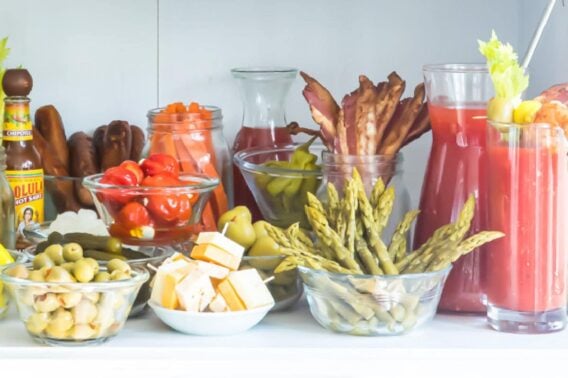

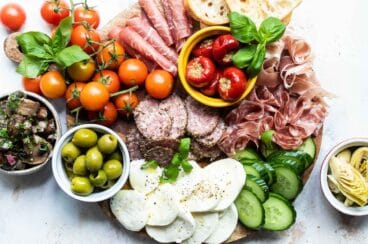
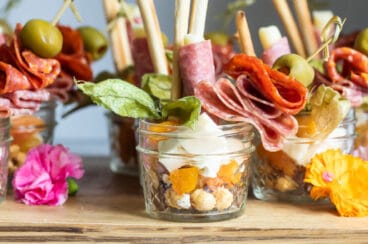
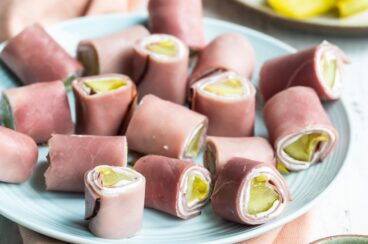
Hi there!
Love this recipe. Could you use elephant garlic?
Thanks!
Jenna
Hi Meggan! I’m excited to try this recipe out! One question I have is – is this recipe suitable for shelf-stable canning? Hope to hear from you. Thanks!
Hi Brit, this recipe is not suitable for shelf-stable canning. Garlic is a low acidic food, so if you make this, even processing in a water bath, it will need to be refrigerated. I hope you enjoy it! – Meggan
Do you use distilled water in this recipe??? If yes how m7ch
Hi Tammy, the pickling liquid used to call for half water and half vinegar. Based on testing and feedback, it’s been updated to use all vinegar. If you prefer to pickle with half water/half vinegar, make sure it’s distilled to prevent the garlic from turning blue. Thank you – Meggan
Fantastic!!
It doesn’t say how much water in the ingredients yet you refer to using distilled water how much
Hi Kim, the pickling liquid used to call for half water and half vinegar. Based on testing and feedback, it’s been updated to use all vinegar. Sorry for the confusion! – Meggan
the written recipe said 5 cups of white vinegar no water is in it but watch the video and the water is there ?
Hi Debbie, I am so sorry about that. I changed the recipe and but never changed the video. I changed the video to match the recipe card now. I am so sorry about the confusion! Have a great day! -Meggan
May I use elephant garlic (actually a leek) instead of true garlic in this recipe?
Hi Sondra, I think so? You can try it and see if you like it. I’m not sure, but I don’t see any issues. Just keep it in the refrigerator. Good luck! -Meggan
Hi, I could just experiment I suppose, but I’m curious what you had in mind: how much dill is a “head”? Thanks, Ch
Hey there, I realize now what a horrible ingredient that is. It’s one of those “who works here?!” moments. A “head” of dill is basically the top part where it flowers. Sort of like queen anne’s lace but yellow? Google “dill head” and you’ll see what I mean. So basically no one who buys dill at the store will ever find that. Some people say you can buy it at the grocery store, but I’ve never seen it there. MAYBE a Farmer’s market would sell it that way. In any case, you should use 1 teaspoon dill seed or dried dill weed, or 3 teaspoons fresh dill. I’ll update the post with this info.
1 teaspoon dill seed/dill weed = 1 dill head / umbel
1 teaspoon dill seed/dill weed = 3 teaspoons fresh
[Source: National Center for Home Food Preservation]
This recipe is awsome. My friends paid me to make more. In some of the jars I put 1/2 of a Habanero to make spicey garlic and it was awesome. For my taste I put 1/3 ,cup of salt. Wait 3 weeks if you can!
Hello,
I ate some pickled garlic for the. First time recently and had to try to make it myself because it was so delicious!
I used your recipe because it had the best ratings. I followed all of the steps and put the jars straight in the fridge.
It’s been 24 hours and I tried one clove and it is so strong and bitter, like eating raw garlic. Is this normal? How long am I meant to wait until I can eat it and does the bitterness go away?
Thank you!
Hi Tash! Sorry for not explaining this in the post/recipe card. Ideally you’d like the garlic sit for at least 3 weeks in the refrigerator (yes, after just one day it will still taste raw). You could definitely test it after one week, two weeks, etc. to see if you like it when it’s done earlier. But 3 weeks, even 6 weeks, is a good amount of time to let the garlic sit in the refrigerator and soak up the brine. Thanks! -Meggan
They’re pickles. You have to pickle them. That does not happen in one night.